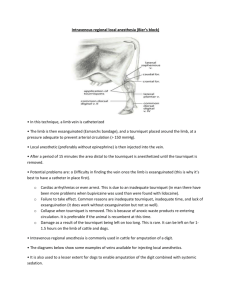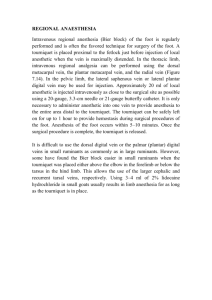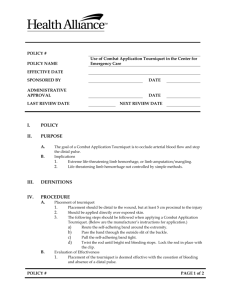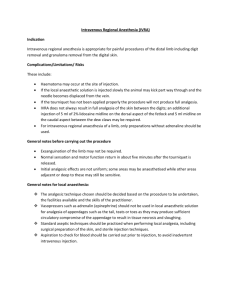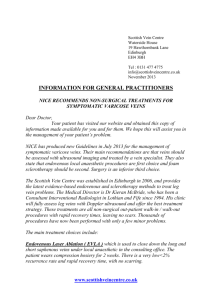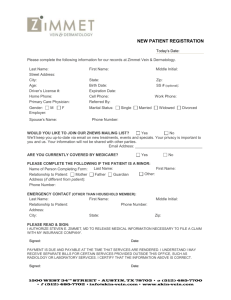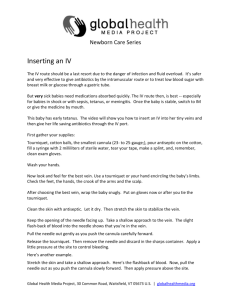venipuncture: part 3 vein assessment and selection
advertisement
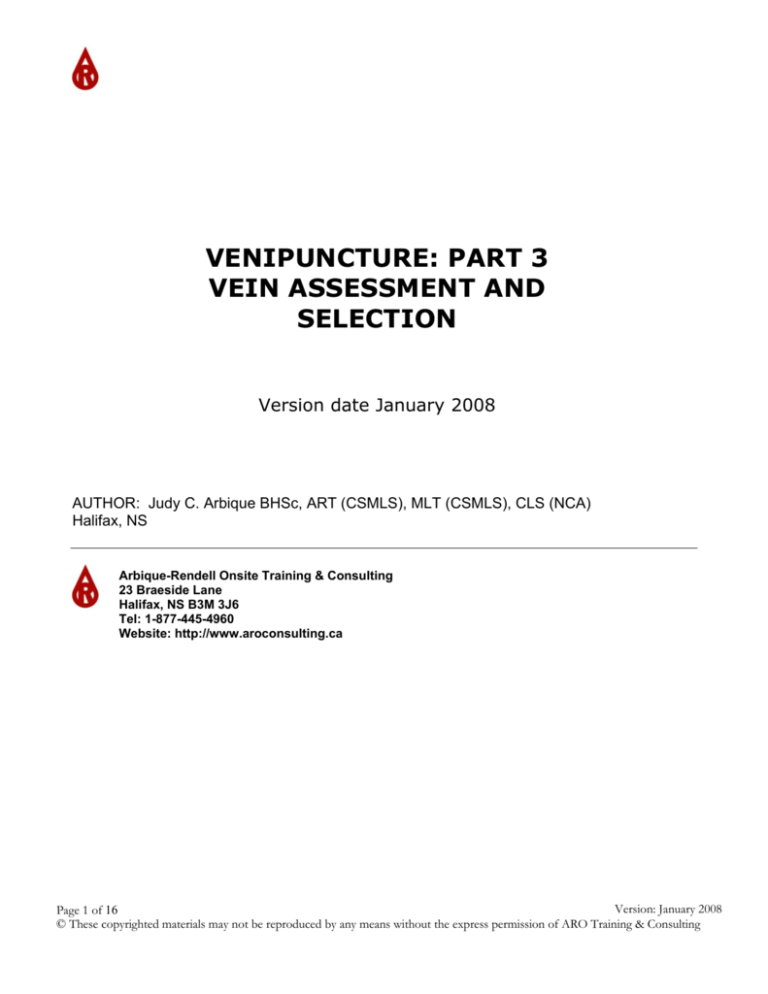
ARO Onsite Training & Consulting Copyright 2008 VENIPUNCTURE: PART 3 VEIN ASSESSMENT AND SELECTION Version date January 2008 AUTHOR: Judy C. Arbique BHSc, ART (CSMLS), MLT (CSMLS), CLS (NCA) Halifax, NS Arbique-Rendell Onsite Training & Consulting 23 Braeside Lane Halifax, NS B3M 3J6 Tel: 1-877-445-4960 Website: http://www.aroconsulting.ca Version: January 2008 Page 1 of 16 © These copyrighted materials may not be reproduced by any means without the express permission of ARO Training & Consulting ARO Onsite Training & Consulting Copyright 2008 Course Prerequisites: § Venipuncture Techniques Modules 1 and 2. Course Goals and Objectives: Goal This course will cover safe techniques and principles for assessment and selection of veins suitable for venipuncture. Course Objectives At the end of this Module the student will be able to: 1. 2. 3. 4. 5. 6. 7. 8. Describe sites to avoid for venipuncture and venous access, and understand the reason(s) for avoiding each. Describe and demonstrate the process for vein selection. Define palpation and demonstrate its proper use. Describe and demonstrate the process for ‘anchoring’ the vein during introduction of the venous access device. Be able to describe various tourniquet designs. Describe infection control issues with respect to choice of tourniquet. Describe the proper use of the strap tourniquet (e.g. latex). Identify methods used to locate veins that are not prominent Version: January 2008 Page 2 of 16 © These copyrighted materials may not be reproduced by any means without the express permission of ARO Training & Consulting ARO Onsite Training & Consulting Copyright 2008 3 VEIN ASSESSMENT AND SELECTION It is important to evaluate and assess the best vein with which to consider for venipuncture. Following application of a tourniquet to slow blood leaving the arm, palpation is used to locate and assess veins to select one suitable for venipuncture. This module will evaluate vein selection, vein handling and correct tourniquet technique. Module 3 Objectives At the end of this module, the learner will be able to: 1. Describe sites to avoid for venipuncture and venous access, and understand the reason(s) for avoiding each. 2. Describe and demonstrate the process for vein selection. 3. Define palpation and demonstrate its proper use. 4. Describe and demonstrate the process for ‘anchoring’ the vein during introduction of the venous access device. 5. Be able to describe various tourniquet designs. 6. Describe infection control issues with respect to choice of tourniquet. 7. Describe the proper use of the strap tourniquet (e.g. latex). 8. Identify methods used to locate veins that are not prominent. 3.1 Introduction A technique called palpation is used to find acceptable veins and distinguish them from other structures in the arm. To palpate a vein, gently and firmly push down on the skin in the elbow crease area with your index finger or middle finger (whichever is most sensitive) and slowly release the pressure. Some sources suggest using the index and middle fingers for palpating; however, this may send 2 conflicting signals to the brain. The thumb should not be used to palpate, because it is not as sensitive as the index finger, and has a pulse that may be confused with the pulse from arteries. Palpating is a skill that is improved through experience – finger sensitivity will improve the more you practice. Improved sensitivity will be useful when feeling for deeper veins that are not visible on the surface. When palpating a vein, you will feel the vein follow your finger back to the surface as you release the pressure and the vein refills with blood. Remember to press on the skin firmly: do not simply rub your finger lightly over the skin – it may feel good to the patient, but will not help you locate veins, especially deeper lying veins. Version: January 2008 Page 3 of 16 © These copyrighted materials may not be reproduced by any means without the express permission of ARO Training & Consulting ARO Onsite Training & Consulting Copyright 2008 Figure 3-I: Palpating the Cubital Fossa © Arbique-Rendell Onsite Training & Consulting Healthy veins feel spongy like elastic tubes that indent when you slowly and gently bounce your finger on them. They are firm and elastic, rebounding readily in response to pressure when palpated. Straight, intact, healthy veins are the easiest to puncture. Light pressure will detect surface veins, whereas, heavier pressure may be needed to detect veins that lie a little deeper in the superficial fascia. Palpating may also indicate the position of vein valves in larger veins, which may appear or feel like a bulge in the vein. Venous access should be avoided in areas of the vein where valves are located. Superficial veins may be difficult to palpate because of their thin walls and the low internal pressure of blood flowing through them. Additionally, they vary in location, despite their textbook description, and may be concealed in the superficial fascia. Because of this, pressure applied 3-4 inches above the vein is used to slow blood return from the arm allowing it to pool. Pooling of blood in the vein distends the vein, making it easier to locate. A tourniquet or blood pressure cuff may be used to apply pressure. Tourniquets and proper tourniquet use are discussed further in the section Tourniquet design and use Extend the patient’s arm fully and in a slightly downward position to find veins. Have the patient close the hand into a fist: this will make the veins more prominent and easier to locate. Do not encourage pumping (vigorous opening and closing) of the fist; otherwise haemoconcentration (plasma and small elements filter into tissue causing an increase in larger cellular elements in the blood) may occur, resulting in erroneous test results. Version: January 2008 Page 4 of 16 © These copyrighted materials may not be reproduced by any means without the express permission of ARO Training & Consulting ARO Onsite Training & Consulting Copyright 2008 Once a vein has been selected, anchor it in place (see Anchoring the vein, following) and mentally visualize the location and position in reference to a mole, hair, skin crease, or other visible landmark so that you can easily relocate the vein prior to insertion of the needle. McCall and Tankersley (Phlebotomy Essentials) suggest placing a fresh alcohol prep pad on the skin just below the intended puncture site with a corner of the pad pointed in the direction that the vein lies. Veins may be visibly apparent as a bluish line beneath the surface of the skin. Other veins may rise visibly as a bulge between the superficial fascia and the skin, depending on sex age and obesity of the patient. Never rely solely on sight—learn to locate veins by touch and palpation, and even if a big vein ‘pops up’, always palpate it to ensure that it has the desired elasticity. The vein may ‘look’ good but may be hard to the touch (sclerosed) requiring you to seek another vein, saving the patient unnecessary discomfort, and you unnecessary embarrassment. Males usually have more prominent veins, and veins in the dominant arm tend to be more prominent as well. In larger arms, the veins are often deeper and harder to find. Very deep veins may be encountered with obese patients. Do not be discouraged: it takes practice to locate these veins. It is helpful to use the “mind’s eye” when locating and feeling. Closing your eyes will improve your sense of touch, and aid in locating deeper veins. Take your time. These veins sometimes take a little longer to become apparent after you’ve tightened the tourniquet. In larger arms, veins can often be palpated with the patient’s arm rotated inward. The median cubital vein is often the most prominent in larger arms. If you are unable to find anything in either arm, ask for help from a more experienced phlebotomist. Do not take a blind stab – If you cannot feel a vein, do not attempt venipuncture! In elderly people, the veins are usually more pronounced as the fascia becomes thinner and veins become more distended. 3.2 Anchoring the vein To anchor or secure the vein firmly in place with the thumb – press into the skin and tissue with the thumb of the non-dominant hand, 1-3 inches below and slightly to the side of the vein. Stretch the skin and tissue towards the wrist in the direction in which the vein runs. Version: January 2008 Page 5 of 16 © These copyrighted materials may not be reproduced by any means without the express permission of ARO Training & Consulting ARO Onsite Training & Consulting Copyright 2008 Figure 3-II: Anchoring the Vein © Arbique-Rendell Onsite Training & Consulting 3.3 Distinguishing veins from other structures • Tendons feel like rope or thread that is stretched tightly, and if you continue to feel while you bend and straighten the patient’s arm, it will remain rope-like; whereas, a vein becomes non-palpable when you bend the arm up. • If you feel a pulse, you are palpating an artery. To reduce the risk of hitting arteries, avoid veins in the vicinity of an artery. 3.3.1 Unacceptable veins Sclerosed veins feel rigid and cordlike, are difficult to puncture, tend to bleed longer following the venipuncture, and may result in inaccurate test results due to impaired blood flow. Thrombosed veins tend to lack elasticity and roll easily. Blood flow is impaired and/or occluded in these veins and may result in inaccurate test results. Small, thready or wiry veins are more difficult to deal with, and once punctured may bleed profusely. Extra care should be taken to stop the bleeding when venipuncture is completed. Tiny superficial veins are often present on the surface of the arm, particularly in the elderly. These veins are generally not large enough for blood taking: find another vein. Version: January 2008 Page 6 of 16 © These copyrighted materials may not be reproduced by any means without the express permission of ARO Training & Consulting ARO Onsite Training & Consulting Copyright 2008 Floating or rolling veins are deceptive: they look promising, but at the point of entry, they can move. Experience will teach you to recognize these veins. Ensure that the vein is anchored securely in place to reduce the risk of the vein rolling away from the needle. Methods used to locate veins that are not prominent: • Massage the arm from the wrist to the elbow to force blood into the veins in the cubital fossa region • Gently tap the antecubital fossa with two fingers • Bend and straighten the arm • Dangle the arm • Rotate the arm inward, and return to its original position • Warm the venipuncture site. Wrap the arm with a warm towel or place a hot water bottle over the cubital fossa region to bring veins to the surface 3.4 Venipuncture sites to avoid Arteries Arteries pulsate. Avoid venipuncture in areas where you feel a pulse. Arteriovenous fistula (AV fistula) An AV fistula is the direct communication between an artery and a vein – a surgical incision is made into each vessel and the two are sutured together (e.g. radial artery to cephalic vein on thumb-side of wrist or lower forearm) for the purposes of dialysis. Do not apply a tourniquet or blood pressure cuff to an arm containing an AV fistula, as the resulting pressure may blow the connection. Venous access should not be performed in these areas due to risk of infection and/or damage to the fistula. Arteriovenous graft (AV graft) An AV graft is a natural graft (autograft or bovine graft) tunnelled under the skin and connected to the distal end of an artery and the proximal end of a vein (e.g. brachial artery to cephalic vein in upper arm) for the purposes of dialysis. Do not apply a tourniquet or blood pressure cuff to an arm containing an AV graft, as the resulting pressure may blow the connection. Venous access should not be performed in these areas due to risk of infection and/or damage to the graft. Version: January 2008 Page 7 of 16 © These copyrighted materials may not be reproduced by any means without the express permission of ARO Training & Consulting ARO Onsite Training & Consulting Copyright 2008 Arteriovenous shunt (AV shunt) An AV shunt is an artificially constructed passage to divert blood flow from artery to vein for the purposes of dialysis. A transparent silicon cannula is threaded into an artery and another into a vein, then tunnelled to the surface and connected to form a loop by joining with a silicon connector. Do not apply a tourniquet or blood pressure cuff to an arm containing an AV shunt, as the resulting pressure may blow the connection. Venous access should not be performed in these areas due to risk of infection and/or damage to the shunt. Central line, venous access devices (VADs), indwelling lines Avoid arms containing central venous catheters such as Hickman and Groshing catheters (surgically implanted); subcutaneous, jugular and subclavian catheters; Medi-Port and Port-aCath catheters. There is a greater risk of infection associated with blood collection through indwelling lines and devices inserted into the patient’s circulatory system. Organisms introduced to the device during blood collection may result in bloodstream infection. Only individuals with complete documented training can access these devices. Edematous areas Avoid areas of excess tissue fluid (edema). These areas pit when palpated. Collection from these sites will result in erroneous test results due to excess substances in tissue fluids. Hematoma Avoid veins with hematomas. Hematomas are characterized by a swelling caused by blood leaking from a blood vessel during or following venipuncture, eventually resulting in a large bruise spreading into the surrounding tissues. Collection in these areas is often more painful, may result in a specimen that is contaminated with haemolysed and old red blood cells. This may represent inaccurate results due to haemoconcentration resulting from blood stasis caused by pressure on the blood vessels. If there is no alternative site, collect below the hematoma site to ensure collection of fresh, free flowing blood. Blood collection in an area where there is a hematoma may result in introduction of old haemolysed red blood cells. Heparin locks A heparin or saline lock may be inserted into a vein for intravenous therapy and/or as a source for repeated blood collections over a 48-hour period. Blood should only be collected from these sites by individuals specifically trained to do so, and with reference to individual institutional policy. Version: January 2008 Page 8 of 16 © These copyrighted materials may not be reproduced by any means without the express permission of ARO Training & Consulting ARO Onsite Training & Consulting Copyright 2008 Intravenous therapy Avoid intravenous (I.V.) sites: go to the other arm, if possible. If veins are not accessible in the other arm, venipuncture may be performed below the I.V. site, in the following manner: 1. Have the I.V. turned off by the patient caregiver for at least 2 minutes to re-establish normal blood flow and remove I.V. fluid from the area 2. Apply the tourniquet between the I.V. site and the area where venipuncture is to be performed 3. Collect a discard tube (tube that does not contain additives or a tube of the same ‘flavour’ (anticoagulant contents) as the first tube to be drawn to remove remaining residual intravenous fluid 4. Collect required tubes following proper order of draw 5. Document on the requisition that blood was drawn from below I.V. and the contents of I.V. fluid Although previous editions of the CLSI venipuncture document clearly stated that blood should not be drawn above an I.V. site, the current edition cautions against this practice, but suggests that venipuncture above the site may be performed if it is not possible below the site. The document acknowledges that blood drawn proximal to the site can be contaminated with intravenous fluid, and recommends that facilities establish their own policies concerning venipuncture proximal to an intravenous site. Mastectomy side Blood should not be collected from the same side as a mastectomy. The mastectomy procedure often involves removal of lymph nodes, reducing the flow of lymph fluid and lymph drainage from the affected arm. Levels of lymphocytes and waste products may also be increased in samples from the affected arm. In addition, the area may be more prone to infection due to loss of protective functions of the lymphatic system. It may also be uncomfortable for the patient. Scarred areas Avoid burned or healed burn areas as well as other areas of extensive scarring, including fresh tattoos. Veins in these areas may be difficult to palpate, have decreased circulation, and are susceptible to infection. Version: January 2008 Page 9 of 16 © These copyrighted materials may not be reproduced by any means without the express permission of ARO Training & Consulting ARO Onsite Training & Consulting Copyright 2008 Lower extremities Alternative sites in the lower extremities (e.g. ankle) must not be used without the permission of the physician due to the risk of complications resulting from thrombosis, infection and phlebitis. To protect the phlebotomist in the event of subsequent complications, it is recommended that physician permission be in writing. 3.5 Tourniquet use Pressure applied by the tourniquet slows venous flow in superficial veins without affecting arterial flow — more blood flows into the veins than out. This causes blood to accumulate in the veins, distending them and allowing them to be more easily located. The tourniquet is applied 3 to 4 inches above the venipuncture site. If a patient has sensitive skin, the tourniquet can be applied over a sleeve, or dry washcloth or gauze wrapped around the arm. When applied correctly, the tourniquet should feel slightly tight to the patient. It should not be rolled or twisted, and it should not be so tight that it pinches or hurts or that the arm turns red or purple. A tourniquet that is fastened too tightly may result in insufficient blood flow to the arm, nerve injury, and/or altered test results by increasing the ratio of cellular elements to plasma (haemoconcentration). Results for plasma cortisol, iron, lipids, protein, potassium, and calcium will be falsely elevated if the pressure is too tight or applied for too long. To minimize the effects of stasis and haemoconcentration during venipuncture, the tourniquet should not be left in place longer than 1 minute. This may mean that the tourniquet may have to be applied twice during the procedure—once for vein selection, and again immediately before vein puncture. In contrast, a tourniquet that is too loose will be ineffective. 3.5.1 Tourniquet design There are a number of types of tourniquets in use: 1. 2. 3. 4. Pliable strap Velcro strap Buckle-closure Blood pressure cuff Of the tourniquet types listed above, the pliable strap tourniquet is the least expensive, followed by the Velcro strap, and then the buckle-closure straps (ranging from $15 to $80). Infection control practice is moving towards dedicated equipment for individual patients in an attempt to restrict the spread of hospital-acquired infection and antimicrobial-resistant Version: January 2008 Page 10 of 16 © These copyrighted materials may not be reproduced by any means without the express permission of ARO Training & Consulting ARO Onsite Training & Consulting Copyright 2008 bacteria. As dedicated use becomes the norm, the cost of dedicated patient use of buckleclosure tourniquets will prohibit their use. 3.5.2 Pliable straps A pliable strap or latex strip tourniquet is applied by positioning it around the arm while grasping the ends and applying a small amount of tension. While maintaining tension, the left end is crossed over the right end and both ends are grasped between the thumb and forefinger at the point where they cross, close to the patient’s arm. The left end is tucked under the right end using either the left middle finger or right finger, resulting in a loop with the end of the tourniquet pointing toward the shoulder. A slight tug on this end of the tourniquet should easily release it from the patient’s arm. The advantage of this type of tourniquet is that it is disposable, preventing cross infection of patients. Latex does not readily support bacterial growth and, if soiled, can easily be wiped clean with disinfectant – inexpensive disposable latex tourniquets are available as well. The disadvantages of latex tourniquets are that they cannot be loosened gradually, they may pinch the skin of elderly patients, and they cannot be reapplied with one hand once loosened. One major concern is the increasing number of patients that are becoming allergic to latex. Latex tourniquets cannot be used on these patients. Figure 3-III: Pliable Strap Tourniquet Application © Arbique-Rendell Onsite Training & Consulting Version: January 2008 Page 11 of 16 © These copyrighted materials may not be reproduced by any means without the express permission of ARO Training & Consulting ARO Onsite Training & Consulting Copyright 2008 3.5.3 Velcro strap Velcro closure tourniquets are made of elastic material with a long band of Velcro to allow a wide range of adjustment. These are reportedly easier to apply and release than straps, although that has not been the author’s experience. The straps can be wiped clean with disinfectant, if soiled. The disadvantages of Velcro strap tourniquets are that they cannot be loosened gradually, they cannot be reapplied with one hand once loosened, and they may not fit very thin or very thick arms (Velcro strips may not be long enough to meet) Velcro strap tourniquets are more expensive than pliable strap tourniquets. 3.5.4 Buckle Closure Buckle-closure tourniquets are made of cloth webbing and have a buckle closure (seat-belt design). The tourniquet stays on the patient’s arm when released, can be gradually loosened and can be tightened again if necessary. Some types of buckle-closure tourniquets are designed to be easily loosened and tightened with one hand. These types of tourniquets are not disposable, and are not easily cleaned if soiled with blood or otherwise contaminated. In institutions where dedicated patient equipment is required, it is unlikely that these tourniquets will be available due to their cost and restricted use. Figure 3-IV: Buckle Closure Tourniquet © Arbique-Rendell Onsite Training & Consulting Version: January 2008 Page 12 of 16 © These copyrighted materials may not be reproduced by any means without the express permission of ARO Training & Consulting ARO Onsite Training & Consulting Copyright 2008 3.5.4 Blood Pressure Cuffs Blood pressure cuffs may be used in place of a tourniquet. The cuff is inflated to a pressure between the systolic and diastolic readings (~90-100 mm Hg). The cuff should not be inflated above 160. Blood pressure cuffs are very useful for patients with difficult veins. Figure 3-V: Blood Pressure Cuff © Arbique-Rendell Onsite Training & Consulting Version: January 2008 Page 13 of 16 © These copyrighted materials may not be reproduced by any means without the express permission of ARO Training & Consulting ARO Onsite Training & Consulting Copyright 2008 3.6 Strap tourniquet application 1. Position the tourniquet 2-3 inches above the elbow crease. 2. Lay one end of the strap tourniquet over the other, forming an “X”. 3. Place the hand holding the underlying end of the tourniquet (left over right or right over left depending on which hand is dominant). Usually the dominant hand will control the underlying end of the tourniquet. In the diagram above, the left hand is the dominant hand. 4. Place the hand holding the underlying end of the tourniquet firmly against the bicep with the fingers under the tourniquet strap against the bicep, thumb on top. Apply tension to the overlying end of the tourniquet with the dominant hand (in the diagram above, the right hand is the non-dominant hand). Stretch the overlying end of the tourniquet until the desired tension is reached. Grasp both ends of the tourniquet where they cross with the thumb and forefinger of the hand holding the underlying strap and release the nondominant hand. Version: January 2008 Page 14 of 16 © These copyrighted materials may not be reproduced by any means without the express permission of ARO Training & Consulting ARO Onsite Training & Consulting Copyright 2008 5. Using the index or middle finger of the non-dominant hand, tuck the overlying tourniquet strap under the underlying strap close to where the “X” is being held by the dominant hand. Tucking the strap close to the “X” will maintain the tension; tucking further from the “X” causes the tourniquet to loosen. When properly performed, both ends of the tourniquet point towards the shoulder, preventing contamination of the intended venipuncture area. 6. A slight tug on the end of the tourniquet that is looped under will easily release it from the patient’s arm. 3.6.1 Further tourniquet tips A cloth or sleeve can be placed under the tourniquet to protect fragile and sensitive skin. Tourniquets should not be applied over open sores. Tourniquets should not be applied to an arm on the side of a mastectomy without physician permission. Tourniquets should not be left on for longer than 1minute. If the tourniquet is left on for longer than 1 minute, it must be removed for at least 2 minutes before being reapplied for vein access. Application of the pliable strap tourniquet can be practiced by tying the tourniquet around your own leg: while sitting place the tourniquet around your leg above the knee and practice applying and releasing the tourniquet until you are comfortable with the technique. Version: January 2008 Page 15 of 16 © These copyrighted materials may not be reproduced by any means without the express permission of ARO Training & Consulting ARO Onsite Training & Consulting Copyright 2008 References 1. Clinical Laboratory and Standards Institute. Procedure for the Collection of Diagnostic Blood Specimens by Venipuncture; Approved Standard - Fifth Edition. CLSI; H3-A5; 23(32); 2003. 2. McCall RE, Tankersley CM. Phlebotomy Essentials – Third Edition. Lippincott Williams & Wilkins. Philadelphia. 2003. Version: January 2008 Page 16 of 16 © These copyrighted materials may not be reproduced by any means without the express permission of ARO Training & Consulting
